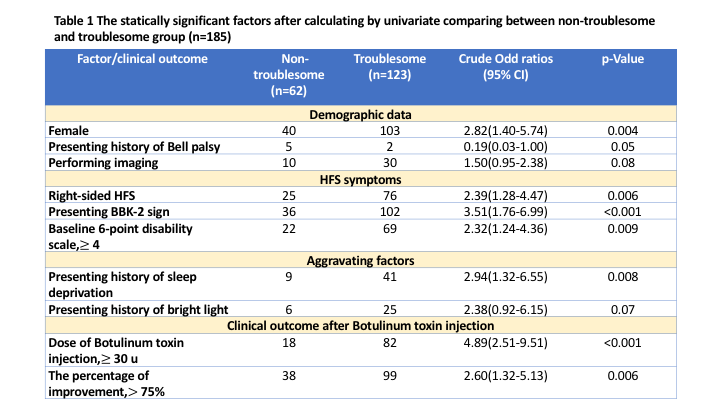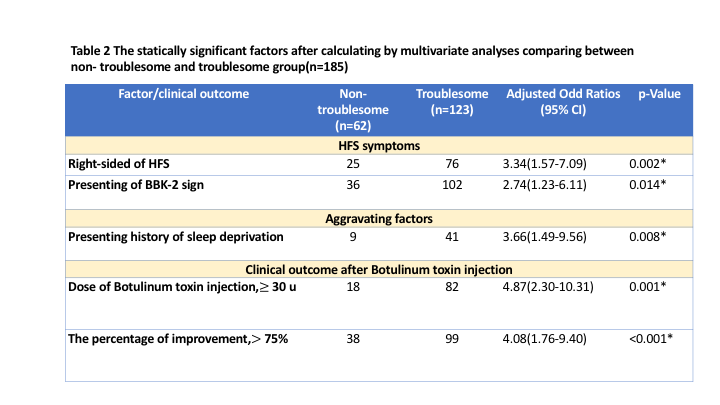Session Information
Date: Saturday, October 6, 2018
Session Title: Myoclonus
Session Time: 1:45pm-3:15pm
Location: Hall 3FG
Objective: To compare the clinical characteristics and treatment outcomes after injection of botulinum neurotoxin (BoNT) type A between non-troublesome and troublesome hemifacial spasm (HFS) in Thais.
Background: HFS is a chronic disabling facial abnormal movement which can cause facial disfigure and, sometimes, impaired vision. However, there has been rarely reported regarding the comparison of the clinical characteristics and treatment outcomes between non-troublesome and troublesome HFS.
Methods: A prospective single-center cohort study was performed in HFS patients registered to BoNT clinic at Siriraj Hospital, Mahidol University, Bangkok, Thailand during August 2017 to February 2018. All patients were collected the demographic data, HFS symptoms, The Babinski-2 (BBK-2) sign, relieving and aggravating factors, and disease severity using SMC grading scale. Treatment outcomes were evaluated by self-reported improvement during peak onset using a visual analog scale (VAS), the latency of onset of action, the time-to-peak onset of action, duration of improvement, and the quality of life (QoL) using a 6-point disability rating scale and adverse events. According to disease severity, all patients were divided into 2 groups including non-troublesome (SMC grade I and II) and troublesome(SMC grade III and IV). Chi-square, T-test, and binary logistic regression were calculated the statistical difference of the clinical characteristics and treatment outcomes between 2 groups.
Results: A total consecutive 185 HFS were included. The prevalence of severe troublesome was 66.5% (n=123). The results demonstrated that the right-sided symptoms, presenting the BBK-2 sign, and history of sleep deprivation were significantly associated with troublesome HFS. The treatment outcomes and adverse events did not show any significant difference between 2 groups, with the exception of the BoNT dosage and the percentage of improvement assessed by VAS.The statically significant factors after calculating by univariate and multivariate analyses were shown in table 1, and 2 respectively.
Conclusions: Our study demonstrated various factors that associated with troublesome HFS. We imply that identifying, correcting these factors and using the appropriate BoNT dosage can provide the satisfactory outcome, even in the higher severity of HFS.
References: 1. Batla A, Goyal C, Shukla G, Goyal V, Srivastava A, Behari M. Hemifacial spasm: clinical characteristics of 321 Indian patients. J Neurol. 2012;259(8):1561-5. 2. Lee JA, Jo KW, Kong DS, Park K. Using the new clinical grading scale for quantification of the severity of hemifacial spasm: correlations with a quality of life scale. Stereotact Funct Neurosurg. 2012;90(1):16-9.
To cite this abstract in AMA style:
Y. Pitakpatapee, A. Suengtaworn, P. Soontrapa, P. Srivanitchapoom. The comparison of the clinical characteristics and treatment outcomes between non-troublesome and troublesome hemifacial spasm in Thai patients [abstract]. Mov Disord. 2018; 33 (suppl 2). https://www.mdsabstracts.org/abstract/the-comparison-of-the-clinical-characteristics-and-treatment-outcomes-between-non-troublesome-and-troublesome-hemifacial-spasm-in-thai-patients/. Accessed April 20, 2025.« Back to 2018 International Congress
MDS Abstracts - https://www.mdsabstracts.org/abstract/the-comparison-of-the-clinical-characteristics-and-treatment-outcomes-between-non-troublesome-and-troublesome-hemifacial-spasm-in-thai-patients/


